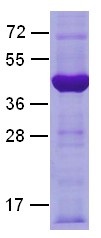Gαi2(Q205L) Protein
| 货号: 10147 |
| 产品名称: Gαi2 Protein Q205L mutant |
| 基因符号: Guanine nucleotide binding protein, alpha inhibiting activity polypeptide 2, GNAI2, Galphai2 |
| Source: Human, recombinant full length, His6-tag |
| Expression 种属反应性: E. coli |
| Molecular Weight: 40 kDa |
| 纯化:: >95% by SDS-PAGE |
| Introduction: Heterotrimeric G proteins are critical cellular signal transducers. Gαi represents one sub-family of G proteins that could mediate the inhibition of adenylyl cyclases. Other biochemical and physiological functions of Gαi proteins are being explored. |
| Amino Acid Sequence (1-355, Q205L) |
MGCTVSAEDKAAAERSKMIDKNLREDGEKAAREVKLLLLGAGESGKSTIVKQMKIIHEDGYSEEECR
QYRAVVYSNTIQSIMAIVKAMGNLQIDFADPSRADDARQLFALSCTAEEQGVLPDDLSGVIRRLWAD
HGVQACFGRSREYQLNDSAAYYLNDLERIAQSDYIPTQQDVLRTRVKTTGIVETHFTFKDLHFKMFDVGG
LRSERKKWIHCFEGVTAIIFCVALSAYDLVLAEDEEMNRMHESMKLFDSICNNKWFTDTSIILFLNKKDL FEEKITHSPLTICFPEYTGANKYDEAASYIQSKFEDLNKRKDTKEIYTHFTCATDTKNVQFVFDAVTDVI IKNNLKDCGLF |
Properties
|
| Physical Appearance (form): Dissolved in 20mM Tris-HCl, pH8.0, 150mM NaCl |
| Physical Appearance (form): White or clear |
| 浓度: 1 mg/mL |
| Storage: -80°C |
Preparation Instructions:
Centrifuge the vial before open the cap and reconstitute in water. Adding of 10 mM β-mercaptoethanol or 1 mM DTT into the solution to protect the protein is recommended and using of non-ionic detergents such as n-Dodecyl β-D-maltoside (DoDM) or polyethylene detergents (e.g. C12E10) also help to stabilize the protein. Avoid repeated freezing and thawing after reconstitution. The purity of His-tagged Gαi2 Q205L was determined by SDS-PAGE and Coomassie Brilliant Blue Staining. |

References:
1. Blatt, C. et al., Proc. Nat. Acad. Sci. 85: 7642-7646, 1988.
2. Bloch, D. B. et al., Am. J. Hum. Genet. 42: 884-888, 1988.
3. Bray, P. et al., Proc. Nat. Acad. Sci. 84: 5115-5119, 1987.
4. Itoh, H. et al., J. Biol. Chem. 263: 6656-6664, 1988.
5. Lan, K.-L. et al., J. Biol. Chem. 273: 12794-12797, 1998.
6. Neer, E. J. et al., Hum. Genet. 77: 259-262, 1987.
7. Ogden, S. K. et al., Nature 456: 967-970, 2008.











